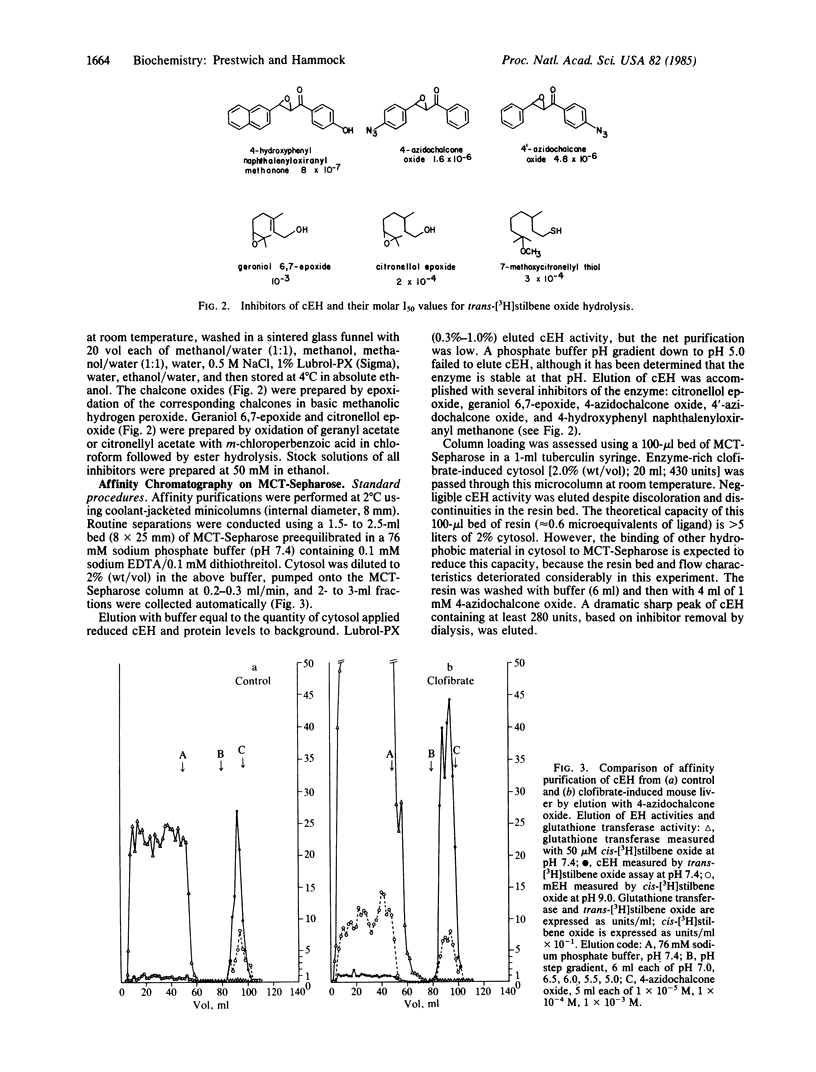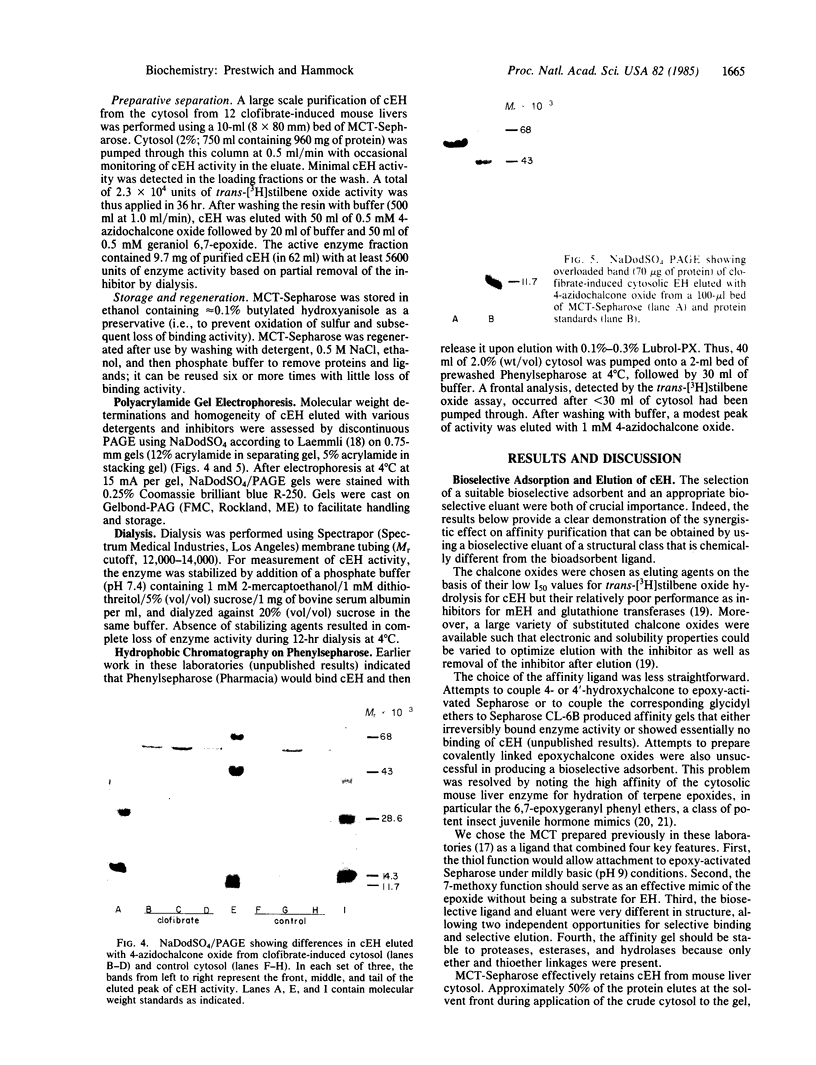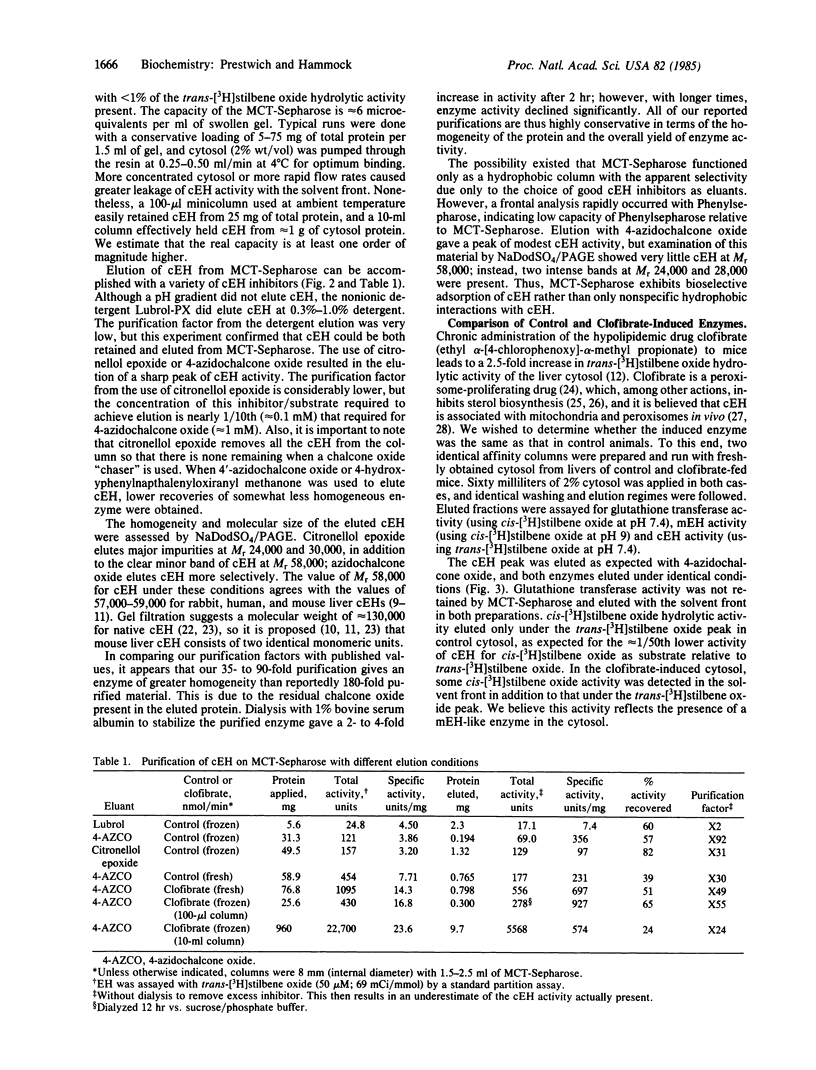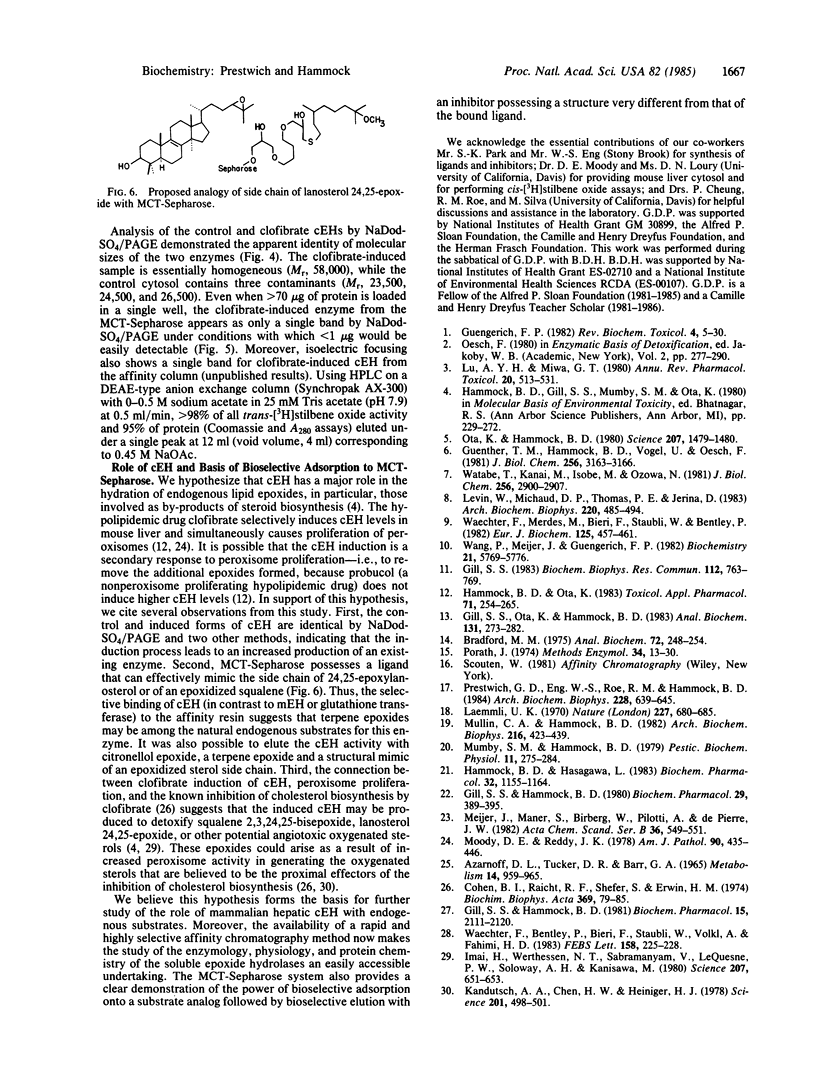Abstract
Epoxide hydrolase from liver cytosol (cEH) of both normal and clofibrate-treated mice can be bioselectively adsorbed onto an affinity column prepared from epoxy-activated Sepharose and 7-methoxycitronellyl thiol. The free ligand is a modest inhibitor of cEH (I50, approximately equal to 3 X 10(-4) M) and lacks the epoxide function necessary for it to be turned over as a substrate. This study demonstrates that a methoxy group can be used to mimic an oxirane in a vertebrate system. Bioselective elution of cEH can be accomplished with several chalcone oxides, which are selective potent inhibitors (I50, 1-50 X 10(-7) M), and activity can be recovered by dialysis. This procedure thus enhances the purification by offering independent opportunities for selective binding and selective elution. Conservatively, a 40%-80% recovery of partially inhibited enzyme activity can be achieved in 4-48 hr with a 30- to 90-fold purification. The purified cEH from clofibrate-induced animals was essentially homogeneous by NaDodSO4/PAGE and had an apparent subunit molecular weight of 58,000. The cEHs from normal and clofibrate-induced animals appeared identical by NaDodSO4/PAGE. Since the cEH activity in normal and clofibrate-treated animals is due to the same enzyme, the increase in cEH activity caused by selected hypolipidemic agents appears to be true induction.
Full text
PDF




Images in this article
Selected References
These references are in PubMed. This may not be the complete list of references from this article.
- AZARNOFF D. L., TUCKER D. R., BARR G. A. STUDIES WITH ETHYL CHLOROPHENOXYISOBUTYRATE (CLOFIBRATE). Metabolism. 1965 Sep;14:959–965. doi: 10.1016/0026-0495(65)90111-3. [DOI] [PubMed] [Google Scholar]
- Bradford M. M. A rapid and sensitive method for the quantitation of microgram quantities of protein utilizing the principle of protein-dye binding. Anal Biochem. 1976 May 7;72:248–254. doi: 10.1016/0003-2697(76)90527-3. [DOI] [PubMed] [Google Scholar]
- Cohen B. I., Raicht R. F., Shefer S., Mosbach E. H. Effects of clofibrate on sterol metabolism in the rat. Biochim Biophys Acta. 1974 Oct 16;369(1):79–85. doi: 10.1016/0005-2760(74)90194-5. [DOI] [PubMed] [Google Scholar]
- Gill S. S., Hammock B. D. Distribution and properties of a mammalian soluble epoxide hydrase. Biochem Pharmacol. 1980 Feb;29(3):389–395. doi: 10.1016/0006-2952(80)90518-3. [DOI] [PubMed] [Google Scholar]
- Gill S. S., Hammock B. D. Epoxide hydrolase activity in the mitochondrial and submitochondrial fractions of mouse liver. Biochem Pharmacol. 1981 Aug 1;30(15):2111–2120. doi: 10.1016/0006-2952(81)90230-6. [DOI] [PubMed] [Google Scholar]
- Gill S. S., Ota K., Hammock B. D. Radiometric assays for mammalian epoxide hydrolases and glutathione S-transferase. Anal Biochem. 1983 May;131(1):273–282. doi: 10.1016/0003-2697(83)90166-5. [DOI] [PubMed] [Google Scholar]
- Gill S. S. Purification of mouse liver cytosolic epoxide hydrolase. Biochem Biophys Res Commun. 1983 Apr 29;112(2):763–769. doi: 10.1016/0006-291x(83)91527-9. [DOI] [PubMed] [Google Scholar]
- Guenthner T. M., Hammock B. D., Vogel U., Oesch F. Cytosolic and microsomal epoxide hydrolases are immunologically distinguishable from each other in the rat and mouse. J Biol Chem. 1981 Apr 10;256(7):3163–3166. [PubMed] [Google Scholar]
- Hammock B. D., Hasagawa L. S. Differential substrate selectivity of murine hepatic cytosolic and microsomal epoxide hydrolases. Biochem Pharmacol. 1983 Apr 1;32(7):1155–1164. doi: 10.1016/0006-2952(83)90264-2. [DOI] [PubMed] [Google Scholar]
- Hammock B. D., Ota K. Differential induction of cytosolic epoxide hydrolase, microsomal epoxide hydrolase, and glutathione S-transferase activities. Toxicol Appl Pharmacol. 1983 Nov;71(2):254–265. doi: 10.1016/0041-008x(83)90342-3. [DOI] [PubMed] [Google Scholar]
- Imai H., Werthessen N. T., Subramanyam V., LeQuesne P. W., Soloway A. H., Kanisawa M. Angiotoxicity of oxygenated sterols and possible precursors. Science. 1980 Feb 8;207(4431):651–653. doi: 10.1126/science.7352277. [DOI] [PubMed] [Google Scholar]
- Kandutsch A. A., Chen H. W., Heiniger H. J. Biological activity of some oxygenated sterols. Science. 1978 Aug 11;201(4355):498–501. doi: 10.1126/science.663671. [DOI] [PubMed] [Google Scholar]
- Laemmli U. K. Cleavage of structural proteins during the assembly of the head of bacteriophage T4. Nature. 1970 Aug 15;227(5259):680–685. doi: 10.1038/227680a0. [DOI] [PubMed] [Google Scholar]
- Levin W., Michaud D. P., Thomas P. E., Jerina D. M. Distinct rat hepatic microsomal epoxide hydrolases catalyze the hydration of cholesterol 5,6 alpha-oxide and certain xenobiotic alkene and arene oxides. Arch Biochem Biophys. 1983 Feb 1;220(2):485–494. doi: 10.1016/0003-9861(83)90439-3. [DOI] [PubMed] [Google Scholar]
- Lu A. Y., Miwa G. T. Molecular properties and biological functions of microsomal epoxide hydrase. Annu Rev Pharmacol Toxicol. 1980;20:513–531. doi: 10.1146/annurev.pa.20.040180.002501. [DOI] [PubMed] [Google Scholar]
- Meijer J., Månér S., Birberg W., Pilotti A., DePierre J. W. Characterization of cytosolic epoxide hydrolase in mouse liver. Acta Chem Scand B. 1982;36(8):549–551. doi: 10.3891/acta.chem.scand.36b-0549. [DOI] [PubMed] [Google Scholar]
- Moody D. E., Reddy J. K. The hepatic effects of hypolipidemic drugs (clofibrate, nafenopin, tibric acid, and Wy-14,643) on hepatic peroxisomes and peroxisome-associated enzymes. Am J Pathol. 1978 Feb;90(2):435–446. [PMC free article] [PubMed] [Google Scholar]
- Mullin C. A., Hammock B. D. Chalcone oxides--potent selective inhibitors of cytosolic epoxide hydrolase. Arch Biochem Biophys. 1982 Jul;216(2):423–439. doi: 10.1016/0003-9861(82)90231-4. [DOI] [PubMed] [Google Scholar]
- Ota K., Hammock B. D. Cytosolic and microsomal epoxide hydrolases: differential properties in mammalian liver. Science. 1980 Mar 28;207(4438):1479–1481. doi: 10.1126/science.7361100. [DOI] [PubMed] [Google Scholar]
- Prestwich G. D., Eng W. S., Roe R. M., Hammock B. D. Synthesis and bioassay of isoprenoid 3-alkylthio-1,1,1-trifluoro-2-propanones: potent, selective inhibitors of juvenile hormone esterase. Arch Biochem Biophys. 1984 Feb 1;228(2):639–645. doi: 10.1016/0003-9861(84)90033-x. [DOI] [PubMed] [Google Scholar]
- Waechter F., Bentley P., Bieri F., Stäubli W., Völkl A., Fahimi H. D. Epoxide hydrolase activity in isolated peroxisomes of mouse liver. FEBS Lett. 1983 Jul 25;158(2):225–228. doi: 10.1016/0014-5793(83)80583-3. [DOI] [PubMed] [Google Scholar]
- Waechter F., Merdes M., Bieri F., Stäubli W., Bentley P. Purification and characterization of a soluble epoxide hydrolase from rabbit liver. Eur J Biochem. 1982 Jul;125(2):457–461. doi: 10.1111/j.1432-1033.1982.tb06705.x. [DOI] [PubMed] [Google Scholar]
- Wang P., Meijer J., Guengerich F. P. Purification of human liver cytosolic epoxide hydrolase and comparison to the microsomal enzyme. Biochemistry. 1982 Nov 9;21(23):5769–5776. doi: 10.1021/bi00266a007. [DOI] [PubMed] [Google Scholar]
- Watabe T., Kanai M., Isobe M., Ozawa N. The hepatic microsomal biotransformation of delta 5-steroids to 5 alpha, 6 beta-glycols via alpha- and beta-epoxides. J Biol Chem. 1981 Mar 25;256(6):2900–2907. [PubMed] [Google Scholar]




